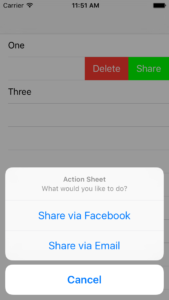This Swift code example will demonstrate how to user UITableViewRowAction to add Table View Row Action Buttons to UITableView.
The code example below will cover:
- Implement UITableView programmatically
- User UITableViewDataSource and UITableViewDelegate protocols to load data into table view and make table row cells interactive
- Load three items from an array into the table view
- Determine device screen size and make table view stretch full width and height
- Implement editActionsForRowAtIndexPath to make table view cell slide to the left side and reveal action buttons
- User UITableViewRowAction to create two table view row action buttons
- Handle events when user taps on UITableViewRowAction button
- Change background color of UITableViewRowAction
- Use UIAlertController to display an Action Sheet when user taps on share action button
- Handle events when user taps on UIAlertController action buttons

UITableViewRowAction. Add Table View Row Action Buttons to UITableView
func tableView(tableView: UITableView, editActionsForRowAtIndexPath indexPath: NSIndexPath) -> [UITableViewRowAction]?
{
let shareAction = UITableViewRowAction(style: .Normal, title: "Share") { (rowAction, indexPath) in
print("Share Button tapped. Row item value = \(self.itemsToLoad[indexPath.row])")
self.displayShareSheet(indexPath)
}
let deleteAction = UITableViewRowAction(style: .Default, title: "Delete") { (rowAction, indexPath) in
print("Delete Button tapped. Row item value = \(self.itemsToLoad[indexPath.row])")
}
shareAction.backgroundColor = UIColor.greenColor()
return [shareAction,deleteAction]
}
UITableViewRowAction. Complete Example in Swift
import UIKit
class ViewController: UIViewController, UITableViewDataSource, UITableViewDelegate {
var myTableView: UITableView = UITableView()
var itemsToLoad: [String] = ["One", "Two", "Three"]
override func viewDidLoad() {
super.viewDidLoad()
// Do any additional setup after loading the view, typically from a nib.
}
override func didReceiveMemoryWarning() {
super.didReceiveMemoryWarning()
// Dispose of any resources that can be recreated.
}
override func viewWillAppear(animated: Bool) {
super.viewWillAppear(animated)
// Get main screen bounds
let screenSize: CGRect = UIScreen.mainScreen().bounds
let screenWidth = screenSize.width
let screenHeight = screenSize.height
myTableView.frame = CGRectMake(0, 0, screenWidth, screenHeight);
myTableView.dataSource = self
myTableView.delegate = self
myTableView.registerClass(UITableViewCell.self, forCellReuseIdentifier: "myCell")
self.view.addSubview(myTableView)
}
func tableView(tableView: UITableView, numberOfRowsInSection section: Int) -> Int
{
return itemsToLoad.count
}
func tableView(tableView: UITableView, cellForRowAtIndexPath indexPath: NSIndexPath) -> UITableViewCell
{
let cell:UITableViewCell = tableView.dequeueReusableCellWithIdentifier("myCell", forIndexPath: indexPath)
cell.textLabel?.text = self.itemsToLoad[indexPath.row]
return cell
}
func tableView(tableView: UITableView, didSelectRowAtIndexPath indexPath: NSIndexPath)
{
print("User selected table row \(indexPath.row) and item \(itemsToLoad[indexPath.row])")
}
func tableView(tableView: UITableView, editActionsForRowAtIndexPath indexPath: NSIndexPath) -> [UITableViewRowAction]?
{
let shareAction = UITableViewRowAction(style: .Normal, title: "Share") { (rowAction, indexPath) in
print("Share Button tapped. Row item value = \(self.itemsToLoad[indexPath.row])")
self.displayShareSheet(indexPath)
}
let deleteAction = UITableViewRowAction(style: .Default, title: "Delete") { (rowAction, indexPath) in
print("Delete Button tapped. Row item value = \(self.itemsToLoad[indexPath.row])")
}
shareAction.backgroundColor = UIColor.greenColor()
return [shareAction,deleteAction]
}
func displayShareSheet(indexPath: NSIndexPath)
{
let alertController = UIAlertController(title: "Action Sheet", message: "What would you like to do?", preferredStyle: .ActionSheet)
let shareViaFacebook = UIAlertAction(title: "Share via Facebook", style: .Default, handler: { (action) -> Void in
print("Send now button tapped for value \(self.itemsToLoad[indexPath.row])")
})
let shareViaEmail = UIAlertAction(title: "Share via Email", style: .Default, handler: { (action) -> Void in
print("Delete button tapped for value \(self.itemsToLoad[indexPath.row])")
})
let cancelButton = UIAlertAction(title: "Cancel", style: .Cancel, handler: { (action) -> Void in
print("Cancel button tapped")
self.myTableView.setEditing(false, animated: true)
})
alertController.addAction(shareViaFacebook)
alertController.addAction(shareViaEmail)
alertController.addAction(cancelButton)
self.navigationController!.presentViewController(alertController, animated: true, completion: nil)
}
}
Check out these short video tutorials on how to use UITableView in Swift:
UITableView in Swift. Video Tutorials.
- Display Large Collection of Images in UITableView with SDWebImage
- UITableViewCell Separator. Hide Separator or Change Left Side Spacing
- UISegmentedControl with UITableView example in Swift. Part 1.
- UISegmentedControl with UITableView example in Swift. Part 2.
[raw_html_snippet id=”cookbookpagecoursesheader”]
Unit Testing Swift Mobile App
Apply Test-Driven Development(TDD) process to iOS mobile app development in Swift Preview this video course.